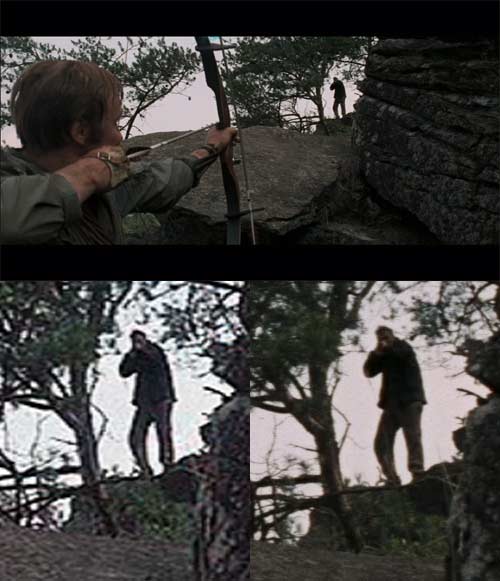 Picture:
Picture:  Sound:
Sound:  Extras:
Extras: 
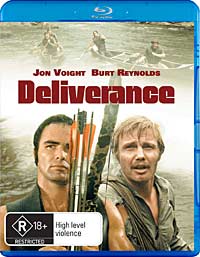
Movie:  Picture:
Picture:  Sound:
Sound:  Extras:
Extras: 
Filmed in the US state of Georgia, it concerns a canoe trip down a wild river, led by Burt Reynolds. Things happen on the way down the stream.
There is little in the story that is admirable. There is narrow-mindedness and bigotry, and not only on the part of the mountain people. There is violence and response and uncertainty. There is lying and cover-up and shame. The 'R' rating which has been retained over the decades could probably be reduced these days to 'MA', but only that far.
All this is delivered credibly by brilliant ensemble acting.
That makes the quality of this Blu-ray a little disappointing. The picture itself does not open up promisingly. With most of the movie set in the woods, it was disheartening to see a confused and soft -- at times, markedly out of focus -- look. This continues throughout. I forgot after a while because the movie is engrossing.
Apparently this is how it was filmed, and has nothing to do with the full high definition VC1 transfer, so I suppose it can never get any better. In any case, it is better than the DVD, artefact free and cleaner in colour.
The sound is appalling. Simple as that. In an attempt to make a mono sound track fill up 5.1 channels, it seems to have been run through a reverb unit. It is the weirdest thing to see four chaps on canoes navigating rapids, barking instructions at each other, and sounding like they're in a not very large, poorly damped, room.
 (Australian rating); Region Free
(Australian rating); Region Free
This is the video bitrate graph for this movie, generated by BDInfo 0.5.2:
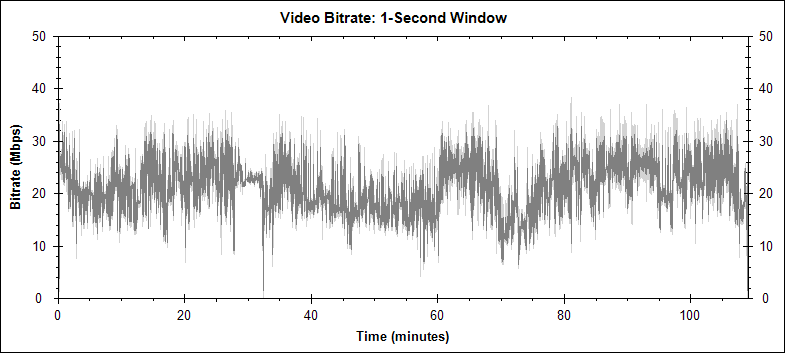
You will have noticed that above I gave only 3.5 stars for picture quality. Here is why:
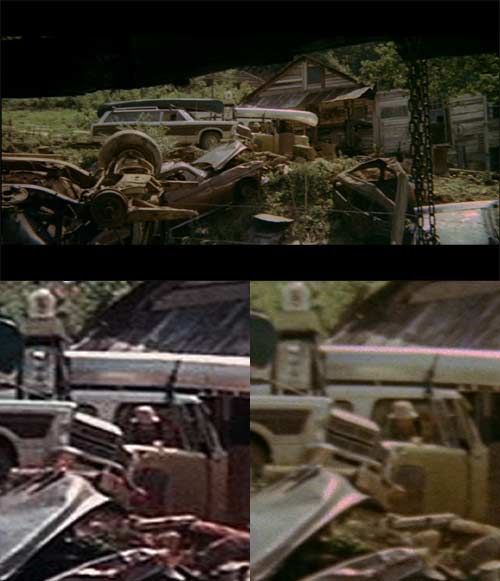
What do we see here? At first glance, the picture seems softer than the PAL DVD. So much so that perhaps it would be better to choose the DVD!
But let's look a bit closer. Underneath the fuzziness of the Blu-ray plicture there is, in fact, more detail. Look at the face of the man under the hat. There is a least a hint of a normally shaped face in the Blu-ray, whereas the DVD just has a narrow horizontal band in a skin tone colour. Look at the upright divider in the grill of the car, visible only on the Blu-ray.
Fact is, the DVD is full of apparent detail which isn't really there at all. It's illusory detail, and is generated artificially. My guess is that the DVD image was 'sharpened' prior to encoding. This process typically involves enhancing contrast differences. It makes the image easier on the eye in one way, because it has more clearly defined edges to latch onto (if the picture is fuzzy, your vision mechanisms assume that your eye isn't properly focused and try to correct this, futilely and tiringly).
Nonetheless, it is a lie because much of the apparent detail simply is not there in reality. Look at the mottled surface of the metal canoe on the more distant car's roof. This is simply subtle variations enhanced and made disturbing by means of the sharpening. And so it goes for every other part of the picture.
To illustrate, below I have applied a great dollop of sharpening (100%, Radius 6.6 pixels) in Photoshop to the right hand part of the picture. Now this Blu-ray source looks a lot more similar to the DVD, even though I operated on the high definition source.
Having said all that, it is clear that different prints of the film were used for the Blu-ray and DVD versions, and I suspect that the print used for the DVD version may have actually been sharper and held more detail than the print used for the Blu-ray version. Here and there in the former there are bits of detail that are absent in the latter which do not appear to be artificially generated lies, but actual original content. For example, compare the rear view mirror attached to the door on the car at the rear, the one from which the man is emerging. This is clearly better defined on the DVD, especially where it attaches to the door.
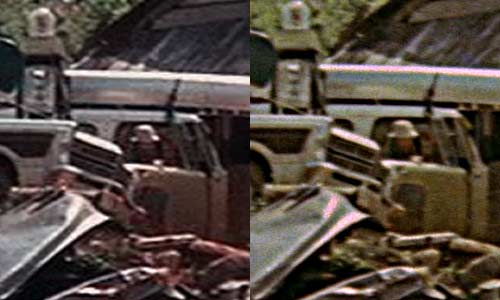
Well, on this one the Blu-ray clearly delivers more readable text than the DVD:
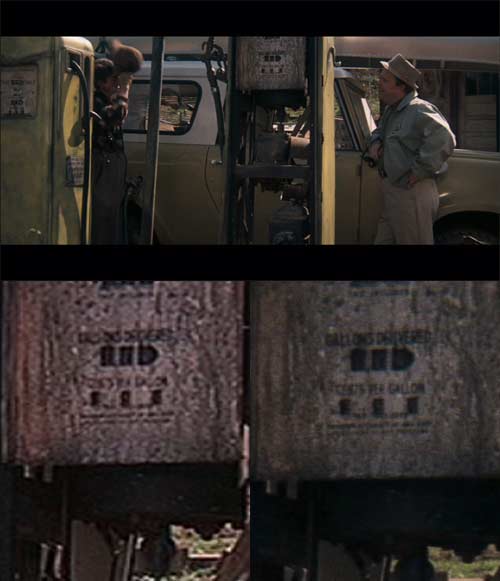
In the end, the Blu-ray is clearly more pleasant to look at. It does indeed have less pseudo-sharpness than the DVD, but it also has a much smoother, more natural finish to it. Note, on this one I increased the DVD to 2,142 pixels wide rather than 1,920. You may see from the other shots that the DVD shots encompasses more than the Blu-ray. For this one, I thought I'd scale the subjects to the same size for each:
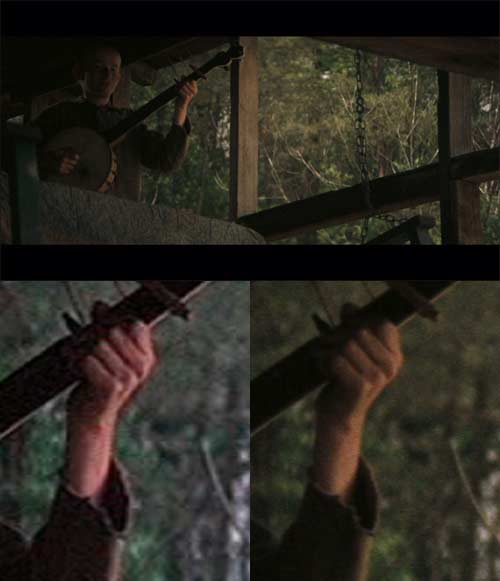
This one (DVD scaled to 1,980 pixels wide for size match) clearly shows how much more natural the Blu-ray looks:
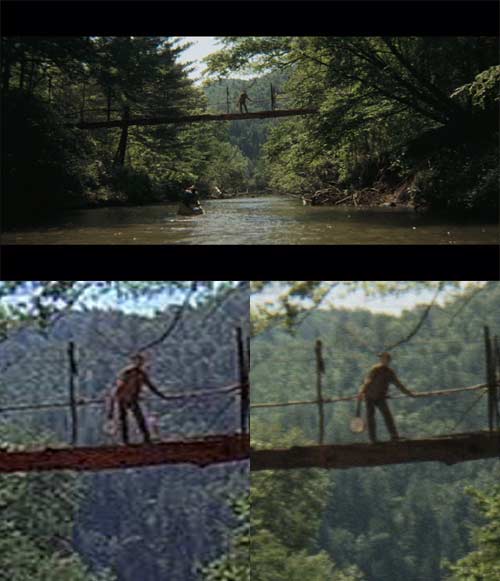
And now to compare something quite different: the framing. Top is DVD, bottom is Blu-ray. Both have been scaled down to 500 pixels wide. The most obvious difference is that the DVD has black bars down either side. These are presumably there to account for overscan on many TVs, so let us simply deplore it and move on.
Next, you can see that more picture is included on the bottom and left of the frame in the Blu-ray version, and less at the right and top of the frame. This is not consistent throughout the movie. Having more of the frame included is not unusual for Blu-ray, since in many cases they have gone back to earlier source material. But losing some to the right and top is odd:
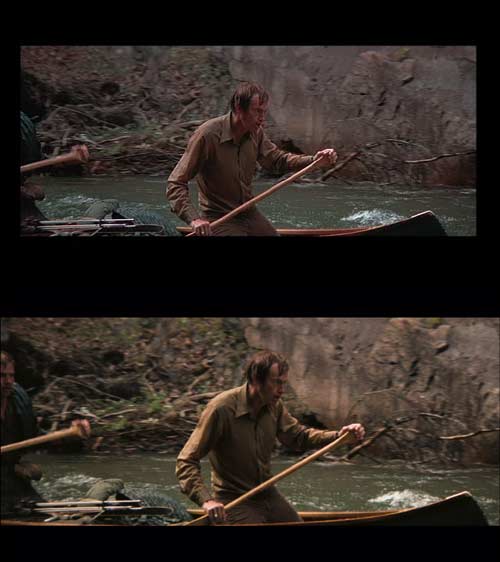
And one more just to finish off. Not much more detail, as such, but a more natural overall appearance. Still, I do wonder if the very best print was used.
